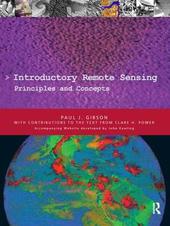
|
Introductory Remote Sensing Principles and Concepts
Paperback
Main Details
| Title |
Introductory Remote Sensing Principles and Concepts
|
| Authors and Contributors |
By (author) Paul Gibson
|
|
By (author) Clare Power
|
| Physical Properties |
| Format:Paperback | | Pages:216 | | Dimensions(mm): Height 246,Width 189 |
|
| Category/Genre | Applied optics |
|---|
| ISBN/Barcode |
9780415196468
|
| Classifications | Dewey:621.3678 |
|---|
| Audience | | Undergraduate | | Postgraduate, Research & Scholarly | | Professional & Vocational | |
|---|
| Illustrations |
16 colour photos, 86 b&w photographs, 51 line figures
|
|
Publishing Details |
| Publisher |
Taylor & Francis Ltd
|
| Imprint |
Routledge
|
| Publication Date |
20 July 2000 |
| Publication Country |
United Kingdom
|
Description
Remote sensing has transformes our understanding of natural processes, the way we view the Earth, and our place in it. The analysis, application and interpretation of remotely sensed images has brought significant advances in a wide range of fields - from climatology, geology, agriculture and oceanography to urban planning, environmental monitoring, marketing and insurance. Yet seeking to obtain further information and a deeper understanding of remote sensing can be daunting, leading to conclusions that remote sensing is a complex subject conposed of an unfathomable range of components. Introduction to Remote Sensing Principles and Concepts provides a comprehensive introduction to both the theory and application of remote sensing, unravelling the compexities of this field of science. The book addresses four key questions: What is remote sensing? What principles govern remote sensing? How are remote sensnig data obtained? What are the applications of remote sensing? Chapter 1 introduces the fields of remote sensing and traces its historical defelopmetn and evolution - from aerial platforms and early manned space flights to the sophisticated Earth observation satellites of today. Chapter 2 presents detailed explanations of core remote sensing principles and concepts the theory required before a clear understanding of remotely sensed images can be achieved, Important remote sensing platforms - including Landsat, SPOT and NOAA - are described in Chapter 3, before the final Chapter 4 examines and illustrates many of the applications of remotely sensed images in various fields. A unique Worl Wide Web product accompanies this textbook. Developed by John Keating, for the users of Netscape 3 / Internet Expolrer or above, this Web site supplements the textbook, offering: *over 45 full colour images with descrions, illustrating remote sensing applications for meteorology, geology, vegitation studies, urban studies, oceanography, and environmental application, and spanning the worlds major regions, indlcudsing the Americas, Canada, Argentina, UK, Ireland, Africa, Australasia, Sudan, Oman, Western Europe *Image exercises, with answers *Shorter questions and answers on remote sensing *An online glossary of terms, links to sources of useful remote sensing information available online, and a preview of a companion textbook
|